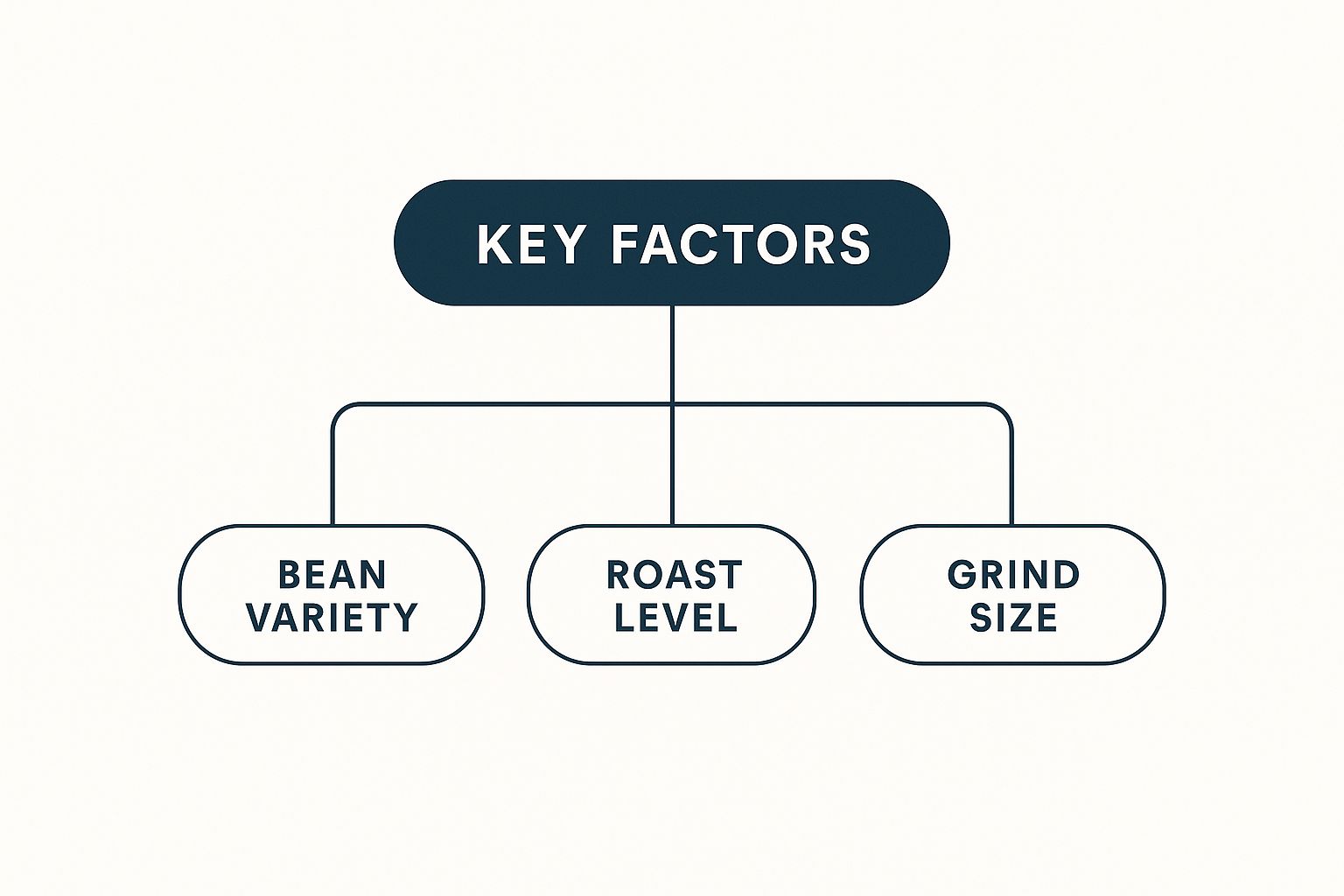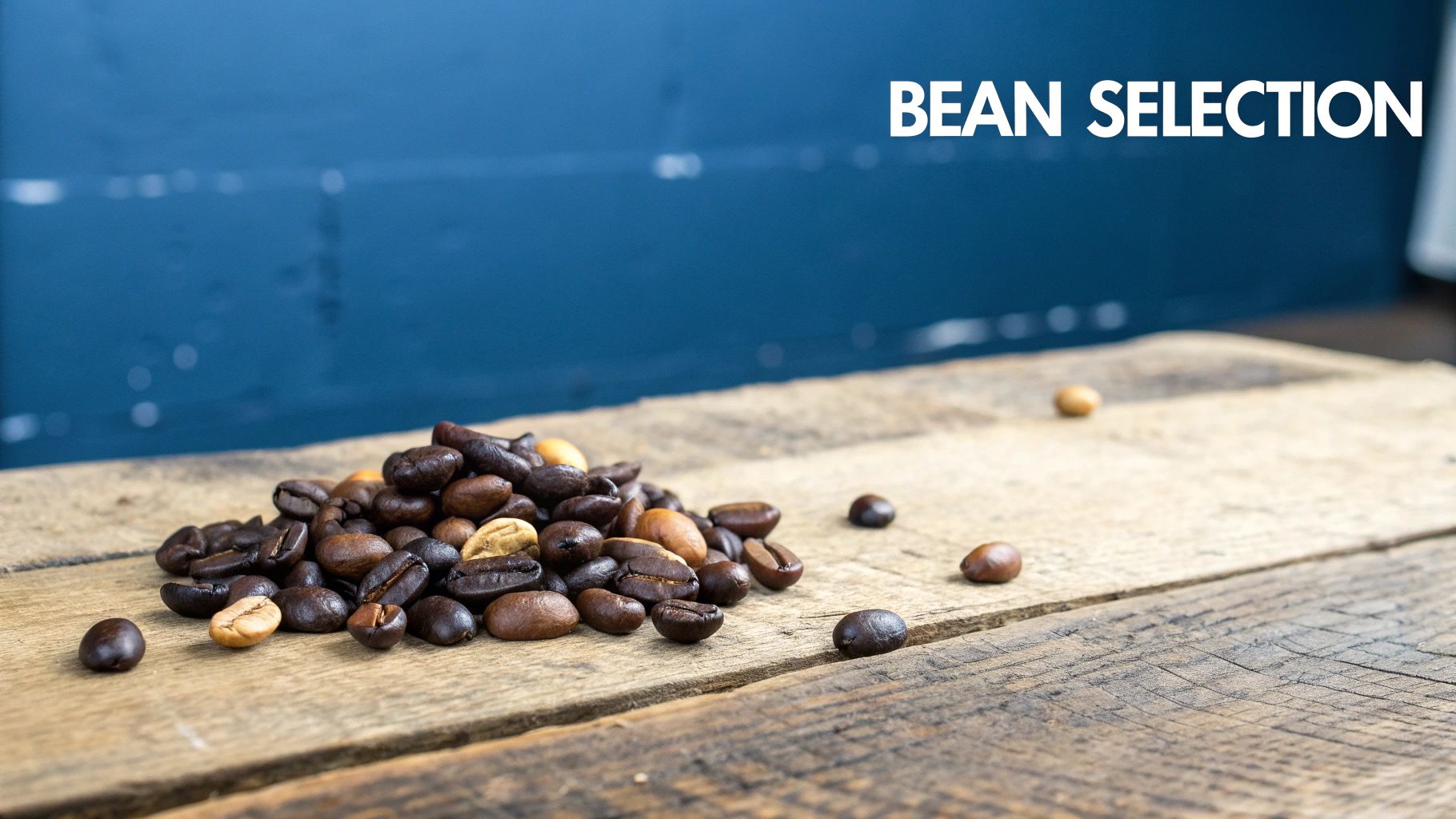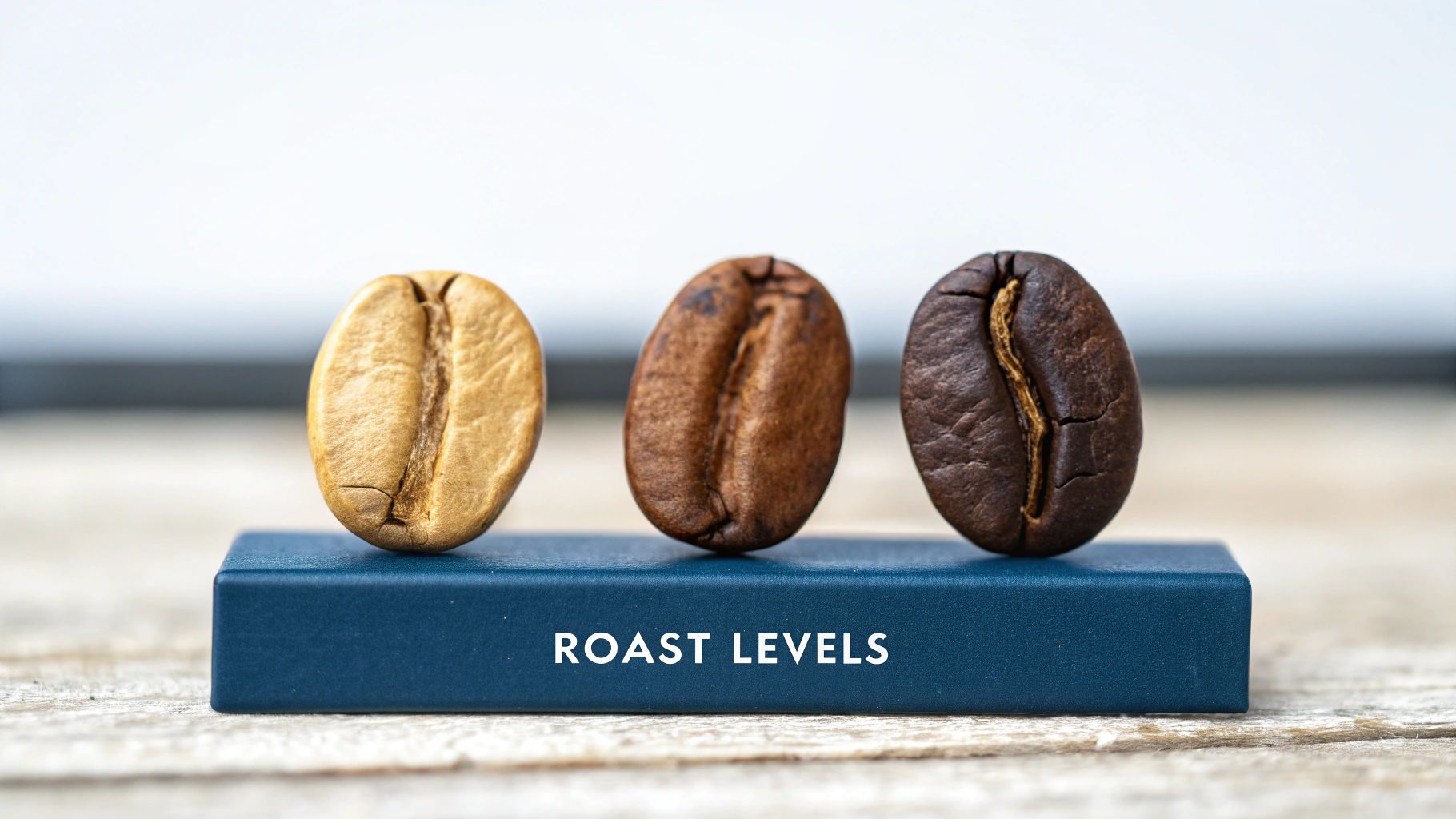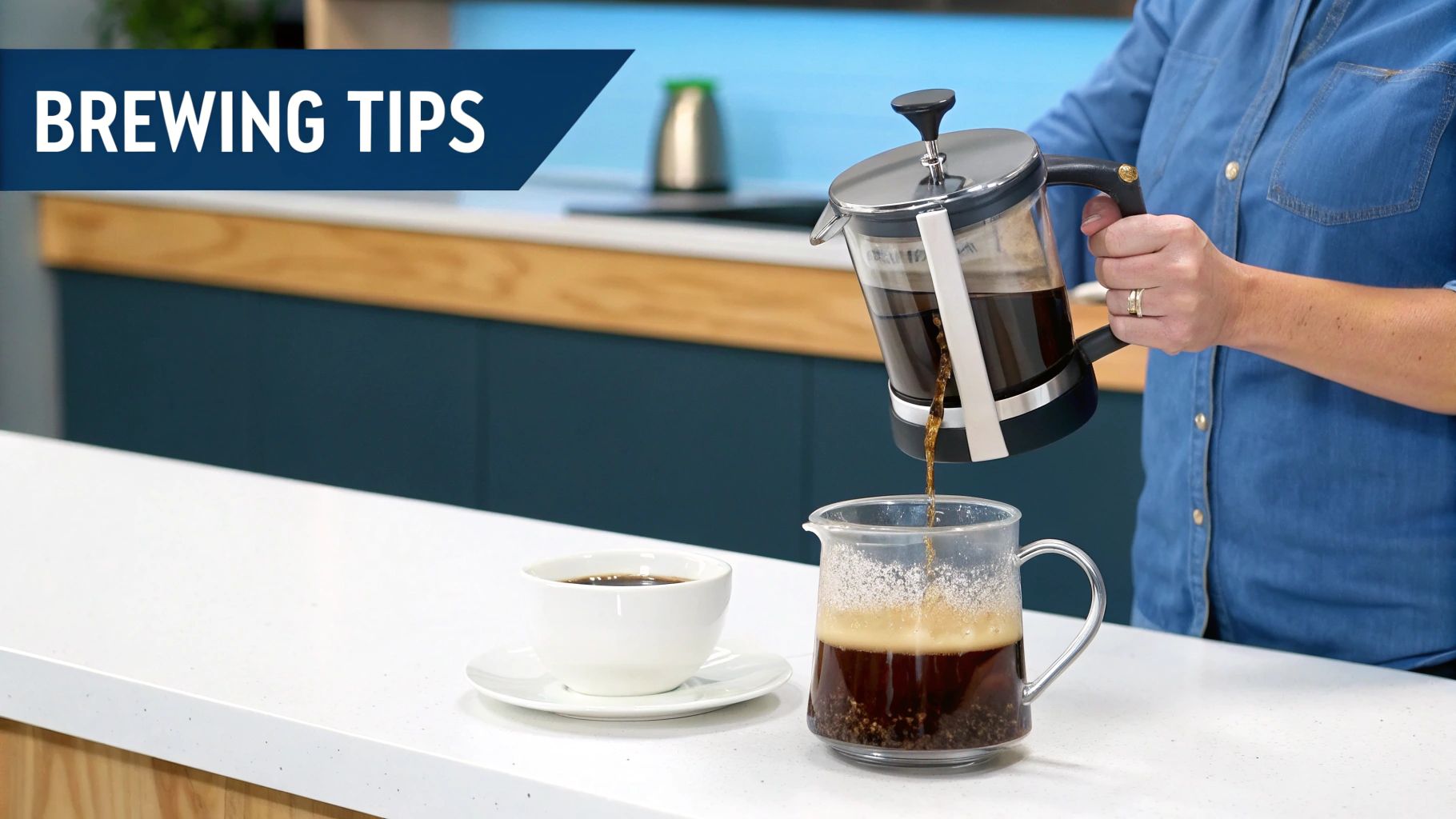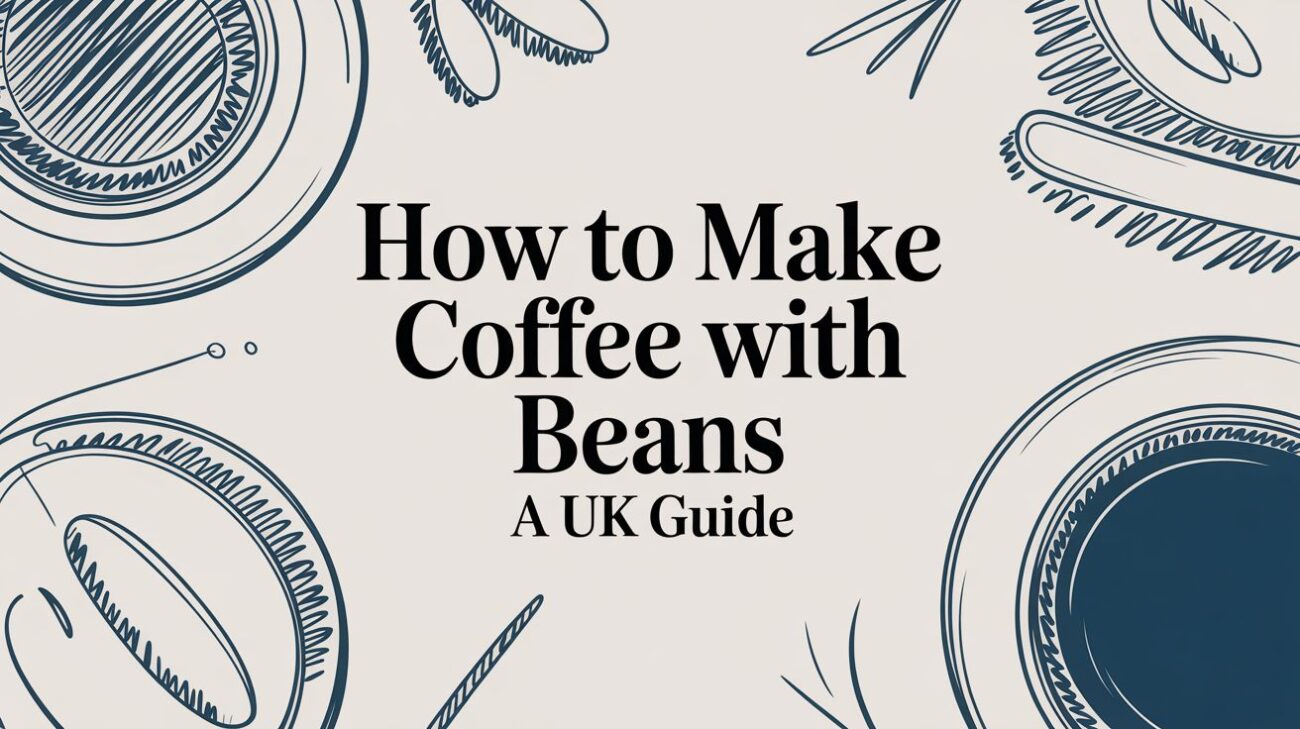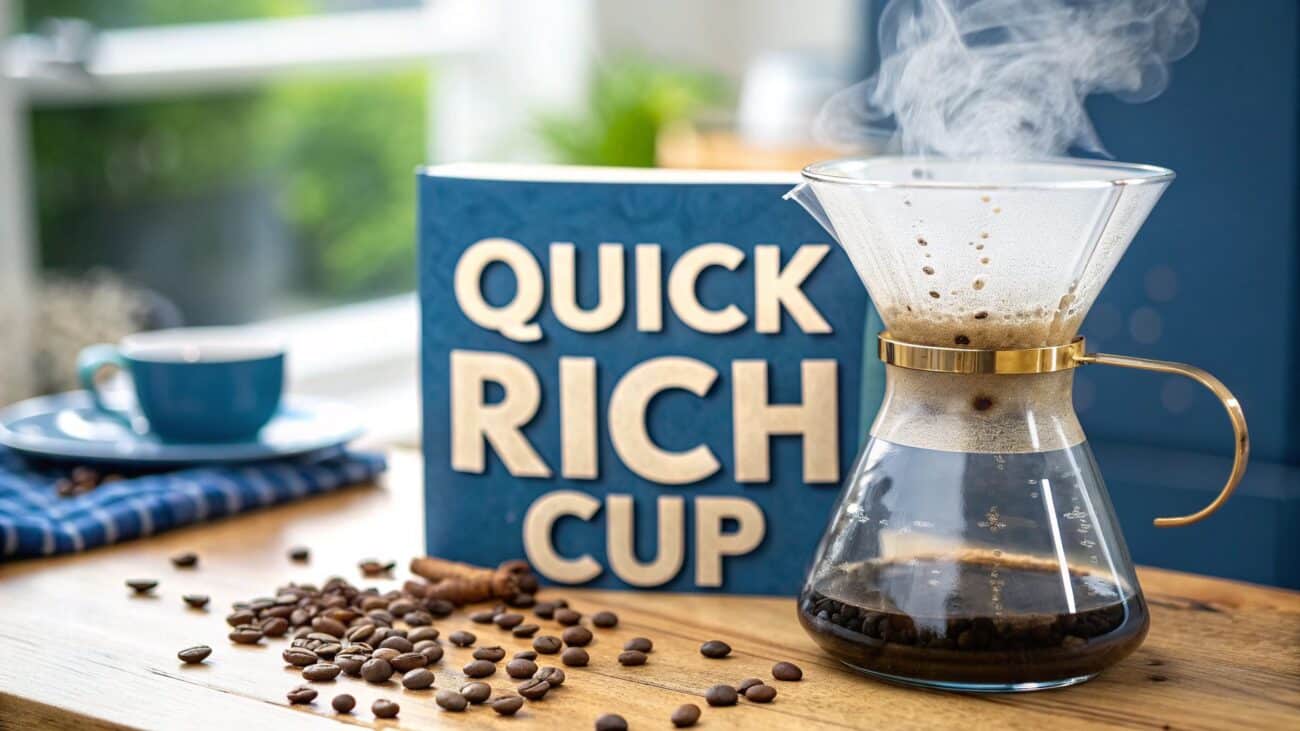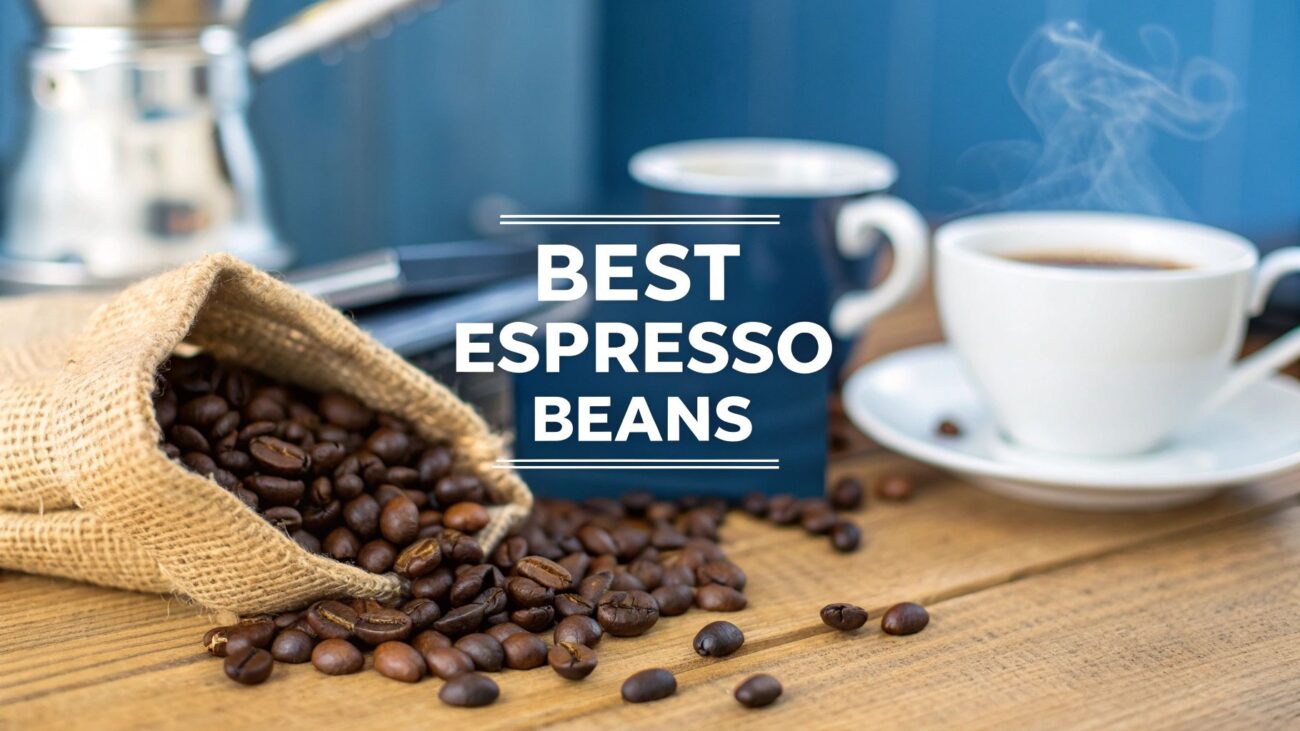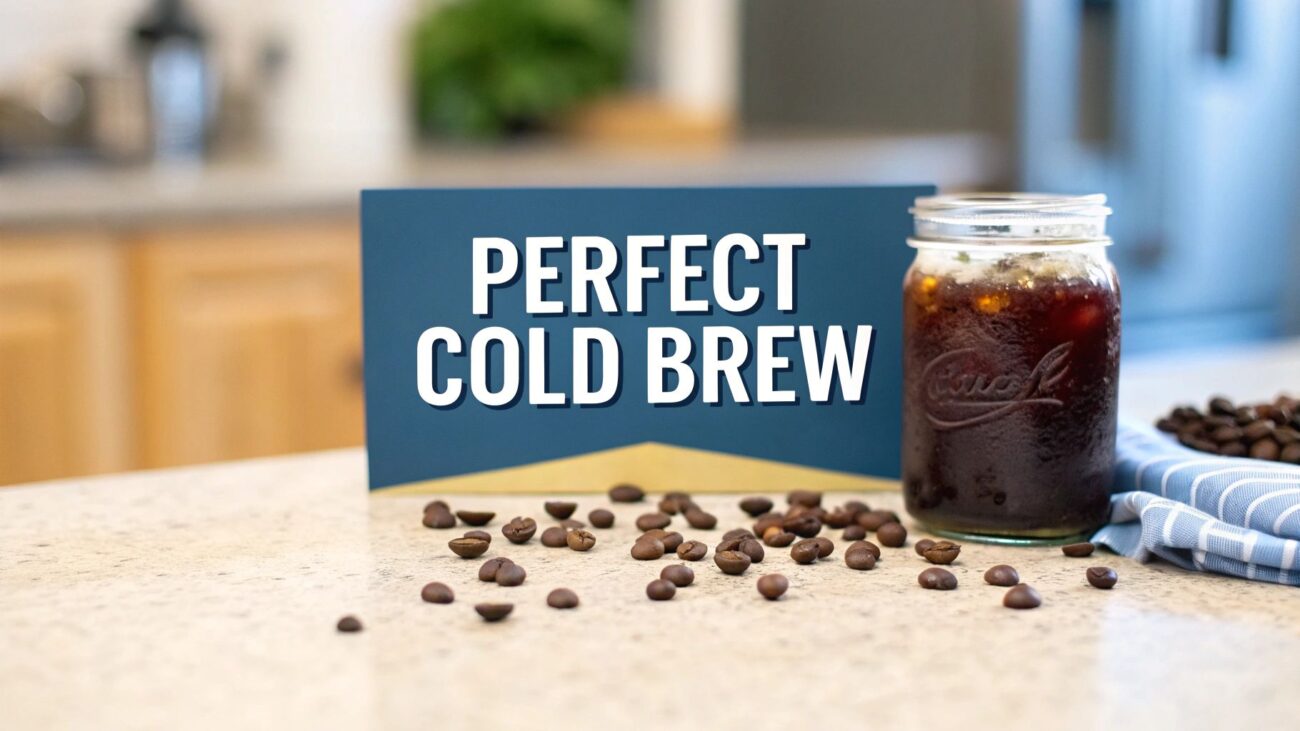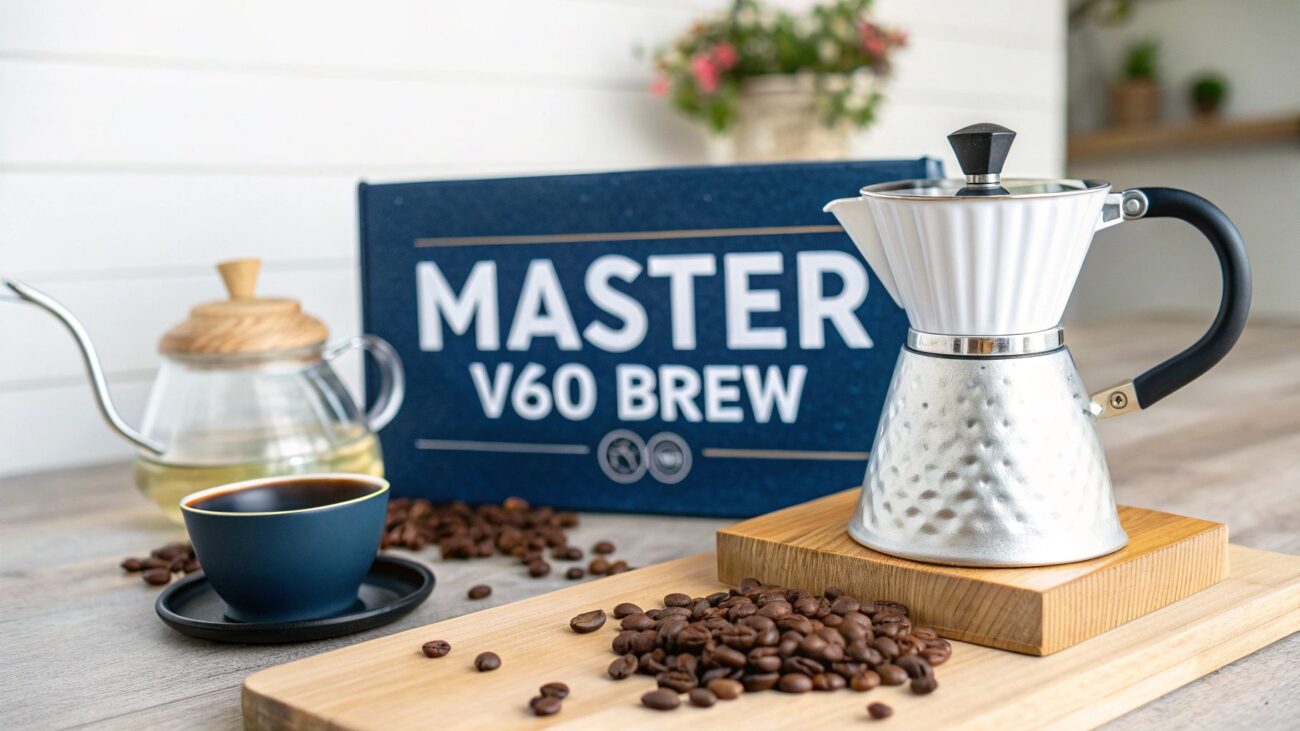Finding the Best Coffee for French Press
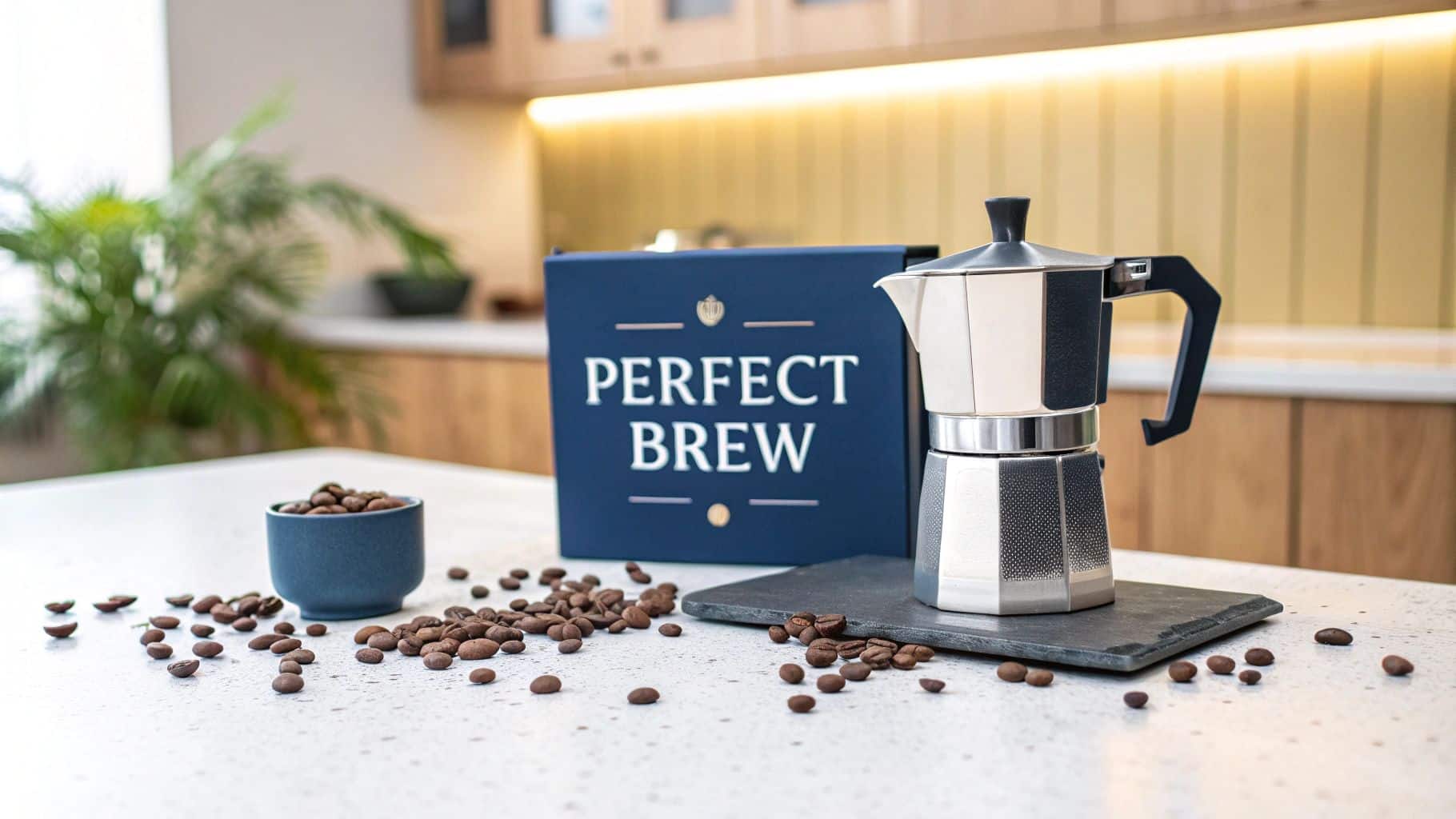
If you want to master the French press, it's not about complex techniques—it's about understanding how a few simple choices work together. The secret to a perfect brew is often decided long before the water even starts to heat up.
Think of it like cooking a perfect steak. The quality of the cut (the beans), the level of heat (the roast), and how you slice it (the grind) all dramatically change the final result. Get these fundamentals right, and you're well on your way to brewing consistently brilliant coffee, every single time.
This guide will walk you through each of these critical elements. We’ll go beyond simple recommendations to explain the ‘why’ behind them, giving you the confidence to choose the best possible coffee for your French press.
Key Factors for Perfect French Press Coffee
To get started, let’s quickly break down the most important characteristics of coffee when brewing with a French press. Each of these elements plays a crucial role in shaping the final flavour and texture in your cup.
| Characteristic | Recommendation | Why It Matters |
|---|---|---|
| Roast Level | Medium to Medium-Dark | Balances body and flavour without introducing excessive bitterness. |
| Grind Size | Coarse | Prevents over-extraction and stops fine particles from passing through the filter. |
| Bean Freshness | As fresh as possible | Freshly roasted beans retain the volatile oils that create rich aroma and flavour. |
| Bean Origin | Personal preference, but South/Central American beans are a great starting point | Origins like Brazil or Colombia offer classic chocolatey and nutty notes that shine in a French press. |
Paying attention to these details is what separates a decent cup of coffee from a truly exceptional one.
Understanding the Key Factors
To start, let's visualise how these core components fit together. This diagram shows the three main pillars of a great French press coffee.
As you can see, bean variety, roast level, and grind size are the foundational elements that determine the final flavour in your cup.
This brewing method has become increasingly popular in the UK, reflecting a wider shift towards speciality coffee. While instant is still a staple in many homes, there's a growing appreciation for more artisanal methods. This trend is particularly noticeable among younger coffee drinkers who enjoy experimenting with different beans and brewing styles. You can discover more insights about UK coffee trends on the British Coffee Association website.
The French press is an immersion brewer, meaning the coffee grounds and water steep together for several minutes. This direct contact makes it exceptionally good at extracting deep, rich flavours and oils, but also makes it sensitive to the wrong grind or roast.
By focusing on these key factors, you take control of the brewing process. Each element—from the origin of the bean to the coarseness of the grind—plays a vital role in crafting a smooth, flavourful, and satisfying cup of coffee every single time.
Why Grind Size Is The Most Important Step
Of all the variables you can tweak when making a French press, none will make or break your cup quite like the grind size. Get this one wrong, and nothing else matters.
Imagine making tea. If you used a fine powder instead of whole leaves, you’d end up with a bitter, sludgy mess. It’s the exact same principle with coffee. The French press is an immersion brewer, meaning the grounds and water hang out together for a few minutes. This process demands a specific grind to work its magic.
Go too fine, and those tiny particles will do two things: clog up the metal filter and sneak right through it into your cup. You'll also find it nearly impossible to press the plunger down. Go too coarse, and the water just won't have enough time to pull out all the delicious flavours locked inside the bean. The result is a weak, sour, and deeply disappointing brew that we call under-extracted.
Finding The Perfect Coarse Grind
So, what's the sweet spot? For a French press, you're aiming for a coarse and uniform grind. Think chunky sea salt or rustic breadcrumbs.
This size is the key. It’s large enough that the filter can easily hold it back, but it's also got enough surface area for the water to work its magic over the standard four-minute brew time. Achieving that consistency across all the grounds is what unlocks the rich, full-bodied character that makes us fall in love with French press coffee in the first place.
The goal is simple: extract the good stuff (oils, sugars, and aromatic compounds) and leave the bad stuff (excess bitterness and acidity) behind. The right grind size is your primary tool for achieving this perfect balance.
Over-Extraction vs Under-Extraction Explained
Let's quickly demystify extraction. Nearly every time you have a bad cup of coffee, it boils down to one of these two problems, and they are almost always tied directly to your grind.
- Over-extraction: This is what happens when your grind is too fine. All that extra surface area means the coffee gives up its flavour too fast, including the nasty, bitter compounds that are meant to stay behind. The result is a harsh, astringent cup of coffee. You’ll also likely notice a layer of fine silt at the bottom of your mug.
- Under-extraction: This is the opposite problem, caused by a grind that's too coarse. The water simply can't get into the centre of the large particles in time, leaving the best flavours trapped inside. This coffee will taste disappointingly weak, sour, and sometimes even a bit salty.
Getting the grind just right is a genuine game-changer. For a much deeper dive into how different grinds pair with various brewing methods, our complete coffee grind size guide has detailed charts and visuals to help you master your grinder for any brewer, not just the French press.
How to Choose Your Ideal Roast Profile
Once you’ve nailed your grind size, the next big decision is the roast profile. The French press is a full immersion brewer, meaning the coffee grounds steep directly in hot water for a good few minutes. This gentle, extended contact dramatically changes how different roast levels express themselves in the final cup.
Think of it like toasting a marshmallow. A light toast is sweet but might lack depth. A charred, black marshmallow is just plain bitter. The sweet spot is that perfect golden brown—rich, caramelised, and delicious. The same idea applies when you’re hunting for the best coffee for your French press.
Why Light Roasts Can Be Tricky
Light roasts are famous for their bright, delicate, and often fruity or floral notes. They hold onto more of the bean’s original character, which sounds great on paper. But that high acidity can become a real problem in a French press.
The full immersion method has a knack for pulling out and amplifying sharp, acidic qualities. It’s all too easy for a light roast to turn disappointingly sour, losing all its intended vibrancy and complexity. While it’s not impossible, getting a balanced brew from a light roast in a French press takes a lot of careful fine-tuning.
The Problem with Very Dark Roasts
At the other end of the scale, you have the dark roasts. These beans are roasted until their natural oils rise to the surface, giving them a shiny, dark look. This process creates deep, smoky, and roasty flavours but dials back the bean's natural acidity.
The issue here is that the French press is incredibly good at extracting oils and big, bold flavours. A very dark roast can quickly become overwhelming, producing a brew that tastes bitter, burnt, or just one-dimensionally smoky. All those subtle nuances get lost, replaced by a harshness that masks the bean’s true quality.
The "sweet spot" for a French press exists because the brewing method highlights the core characteristics of the roast. Medium and medium-dark roasts offer the ideal balance of sweetness, body, and acidity that this immersion style needs to create a truly spectacular cup.
Finding The Perfect Balance with Medium Roasts
This leads us right to the sweet spot for most French press fans: medium and medium-dark roasts. These profiles give you the best of both worlds. They’ve been roasted long enough to mellow out the sharp acidity of a light roast while building a fuller body and delicious sweetness.
These roasts are known for their classic, comforting flavour notes that are a perfect match for the French press.
- Rich Chocolate: Notes of milk or dark chocolate come through beautifully.
- Toasted Nuts: Flavours like almond, walnut, and hazelnut add a smooth, comforting depth.
- Deep Caramel: A rounded sweetness creates a balanced and incredibly drinkable coffee.
They have just enough character to stand up to the immersion process without ever turning bitter. The result is a cup that is full-bodied, smooth, and layered with flavours that feel both familiar and exceptional. To dive deeper into this, you can master every brew by checking out our complete guide to coffee roasting profiles explained.
Exploring Coffee Regions and Flavours
Just like a wine tastes of its vineyard, coffee is deeply rooted in the place it was grown. The soil, the altitude, and the climate of a region—what the experts call its terroir—all come together to create the unique notes you taste in the final cup. Choosing the best coffee for your French press isn't just about picking a roast; it's about going on a flavour journey.
Once you start to understand where your coffee comes from, the way you buy it completely changes. You’ll move beyond grabbing a bag with a generic label and start picking out beans based on the flavours you genuinely love. The French press is brilliant at drawing out a coffee's body and deep sweetness, and certain regions are a match made in heaven for this brewing style.
South and Central America: The Classic Choice
When you picture a classic, comforting mug of coffee, chances are you're thinking of beans from South or Central America. Origins like Brazil, Colombia, and Guatemala are world-famous for producing coffees that have a lovely full body and low acidity.
These beans are the perfect starting point for anyone getting into French press coffee. They consistently deliver those rich, crowd-pleasing notes that this brew method seems to amplify so well.
- Brazil: Known for its smooth, nutty, and chocolatey profiles with a satisfyingly heavy body.
- Colombia: Tends to produce a slightly brighter but perfectly balanced cup, often with notes of caramel, chocolate, and a clean finish.
These regions offer a reliable and delicious foundation for your French press brewing. Their inherent sweetness and substantial body create a smooth, satisfying cup that rarely disappoints, making them an ideal daily brew.
Africa: Bright and Adventurous Flavours
If you're feeling a bit more adventurous, African coffees offer a completely different experience. Beans from countries like Ethiopia and Kenya are celebrated for their vibrant acidity and complex character, which is often fruity or floral.
That brightness can be a little tricky in a French press, but a medium roast from this region can produce a stunningly unique cup. Keep an eye out for Ethiopian beans, which can offer incredible notes of blueberry, bergamot, and jasmine. These coffees are a fantastic showcase of just how diverse coffee can be.
Asia: Earthy and Bold Profiles
Coffees from Asia, especially Indonesia, bring another distinct personality to the table. Sumatran beans, for example, are prized for their heavy, almost syrupy body and deep, earthy flavour profiles. Think dark chocolate, cedar, and even a hint of spice.
These bold characteristics are a superb match for a French press, which captures their full-bodied texture perfectly. The result is a rich, lingering cup that is both powerful and complex. As you start exploring these different origins, you'll begin to appreciate the nuances of what is called single-origin coffee, where every bean comes from one specific farm or region. You can learn more about this by reading our detailed article on what is single-origin coffee.
It's also worth noting that the move towards sustainability is really shaping how we choose our coffee here in the UK. More and more people are looking for traceable, organic, and environmentally friendly beans, a shift driven by younger consumers who prioritise ethical sourcing. So, for many of us, the best beans aren't just delicious—they also meet these important sustainability standards. You can explore the latest UK coffee consumption statistics to learn more about this growing trend.
Our Top UK Coffee Bean Recommendations
Alright, we’ve covered the theory behind what makes a great French press coffee – from the perfect coarse grind to the ideal roast profile. Now it's time to get practical and talk about the beans themselves. Walking into a supermarket or browsing online can feel like a maze of choices, so think of this as your curated shopping list for some of the best beans you can get your hands on in the UK.
The UK’s coffee scene is absolutely buzzing. We’re a nation that genuinely cares about a quality brew, both at home and in our favourite cafés. In fact, Brits spend an average of £16 a month on coffee for their own kitchens, and 80% of coffee shop regulars visit at least once a week. This isn't just a caffeine habit; it's an appreciation for great coffee, and the recommendations below are chosen with that high standard in mind. If you're curious, Balance Coffee has some fascinating stats on UK coffee consumption.
I’ve picked out a few exceptional coffees that really come alive in a French press, striking that perfect balance between being easy to find and offering true artisan quality.
To make things even easier, here's a quick comparison of our top picks. Each one offers a completely different experience, so you can find the perfect match for your mood or preference.
Top Recommended Coffees for French Press
| Coffee Brand & Name | Roast Level | Origin | Primary Flavour Notes | Best For |
|---|---|---|---|---|
| Brazilian Single Origin | Medium-Dark | Brazil | Dark chocolate, toasted almond, caramel | The classic, comforting, and reliable daily brew. |
| Ethiopian Yirgacheffe | Medium | Ethiopia | Jasmine, bergamot, sweet blueberry | An adventurous and aromatic cup with bright, complex notes. |
| Sumatran Mandheling | Medium-Dark to Dark | Sumatra, Indonesia | Dark chocolate, cedar, warming spice | A bold, earthy, and full-bodied coffee experience. |
These recommendations give you a fantastic starting point. Whether you stick with one or try them all, you’re guaranteed a brilliant French press brew. Let’s dive a little deeper into what makes each one so special.
For the Classic Coffee Lover
If your idea of a perfect coffee is that timeless, comforting cup that just hits the spot, then you can't go wrong with a classic single-origin from Brazil. These beans are famous for their low acidity and full body, a combination that feels like it was made for the immersion brewing of a French press.
- Roast Level: Medium-Dark
- Origin: Brazil
- Primary Flavour Notes: Rich dark chocolate, toasted almond, and a smooth, caramelised sweetness.
- Why it works: The French press is brilliant at amplifying its natural nutty and chocolatey character, creating a brew that is smooth, bold, and just deeply satisfying.
This is the kind of coffee that’s a guaranteed crowd-pleaser and makes for an excellent everyday brew.
A great Brazilian coffee in a French press is the definition of comfort. It delivers a consistently rich and balanced cup that feels both familiar and luxurious, making it an ideal starting point for anyone new to brewing.
For the Adventurous Palate
Ready to explore something a bit different? An Ethiopian Yirgacheffe is your ticket to a brighter, more complex profile. While very light roasts can sometimes be a bit tricky in a French press, a medium roast of these beans hits a beautiful sweet spot. It tames the acidity just enough for the press to draw out its incredible aromatic qualities.
It’s a fantastic gateway into the diverse world of specialty coffee beans, where unique flavour profiles are celebrated.
- Roast Level: Medium
- Origin: Ethiopia
- Primary Flavour Notes: Floral jasmine, zesty bergamot, and a subtle hint of sweet blueberry.
- Why it works: The French press captures the coffee’s full body while allowing its delicate floral and fruity notes to sing, creating a vibrant and memorable cup.
For the Bold and Earthy Enthusiast
If you're someone who craves a coffee with a deep, powerful, and lingering character, a Sumatran Mandheling is an exceptional pick. Hailing from Indonesia, these beans are legendary for their heavy, almost syrupy body and complex, earthy undertones.
The French press is uniquely suited to capturing this coffee’s incredible texture and bold flavour profile.
- Roast Level: Medium-Dark to Dark
- Origin: Sumatra, Indonesia
- Primary Flavour Notes: Dark chocolate, cedar, and a hint of warming spice.
- Why it works: The full immersion process pulls out the maximum body and depth from these beans. The result is a rich, potent, and wonderfully complex brew that coats the palate.
Common French Press Coffee Questions
Even when you've got the right beans and a perfect grind, questions inevitably pop up as you get to grips with your French press. This section tackles some of the most common uncertainties people face. Think of it as your go-to guide for troubleshooting the little things and building the confidence to brew a brilliant cup, every single time.
We'll cover everything from using pre-ground coffee in a pinch to getting that water temperature just right. These straightforward answers are designed to help you clear any final hurdles.
Can I Use Pre-Ground Coffee in a French Press?
While you can, it’s generally not the best idea. Most pre-ground coffee you find in the supermarket is ground far too finely for a French press, which often leads to a silty, over-extracted, and bitter cup. It also makes plunging surprisingly difficult.
If you absolutely must use pre-ground, hunt for a bag specifically labelled 'coarse grind' or 'cafetière grind'. For the best possible flavour and clarity, though, grinding whole beans just before you brew is always the way to go. This one simple step keeps the coffee's delicate aromatic oils and peak freshness locked in.
The moment you grind coffee, it begins to lose its most volatile and flavourful compounds. Grinding just before brewing is the single most effective way to capture the bean's true character in your cup.
How Long Should I Brew Coffee in a French Press?
The gold standard for brewing time is four minutes. This is widely seen as the sweet spot for pulling out all the desirable flavours without tipping into bitterness. Just start your timer the moment you've finished pouring hot water over the grounds.
Of course, this is just a starting point, and it’s ripe for experimentation.
- For a stronger brew: You can push the time to five or even six minutes, but be warned—this dramatically increases the risk of over-extraction.
- For a milder brew: A shorter time of three minutes might be your thing, though this can sometimes result in a weak, under-developed coffee.
Kick things off with four minutes, then tweak it from there until it's a perfect match for your taste.
Does the Freshness of the Coffee Beans Really Matter?
Absolutely. Coffee is a fresh agricultural product, and just like any other, its flavour starts to fade the moment it leaves the roaster. Those wonderful oils and aromatic compounds that give coffee its incredible taste and smell begin to dissipate within just a few weeks.
For the richest, most vibrant flavour in your French press, always try to use beans that have been roasted within the last two to three weeks. A 'roasted on' date on the bag is a much better sign of freshness than a 'best before' date. Storing your beans correctly is also key, and you can learn the best ways to do this in our guide on how to store coffee beans to keep them fresher for longer.
What Is the Best Water Temperature?
The sweet spot for water temperature in a French press is just off the boil, usually between 90°C and 96°C. Pouring water at a full, rolling boil (100°C) can actually scorch the delicate coffee grounds, leaving you with a burnt and unpleasantly bitter taste.
A simple, foolproof method is to bring your kettle to a boil, then just let it sit for about 30 to 60 seconds before you pour. This short cooling-off period brings the water right into that optimal range, ensuring a smooth, balanced, and flavourful extraction.
At Seven Sisters Coffee Co, we're passionate about helping you discover the perfect coffee for every moment. Explore our carefully sourced and expertly roasted beans to elevate your next French press brew. Find your new favourite today at https://sevensisterscoffee.co.uk.

